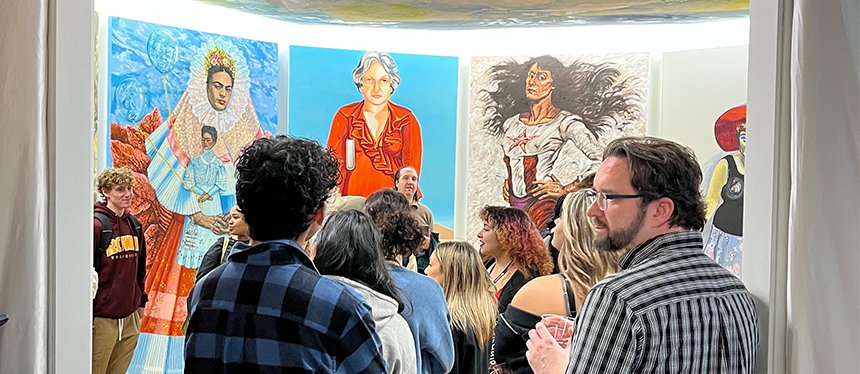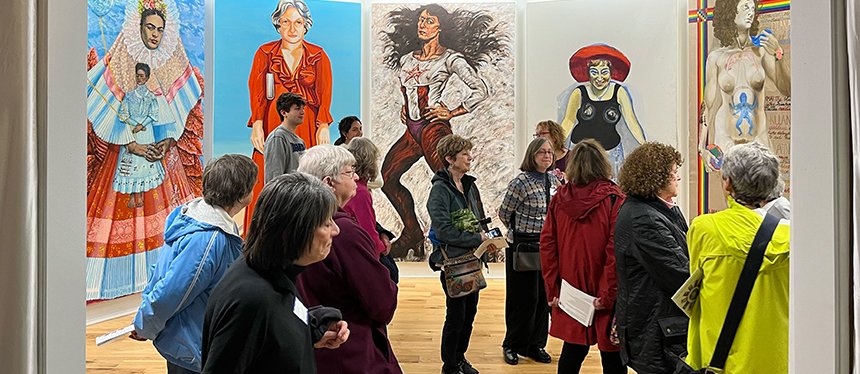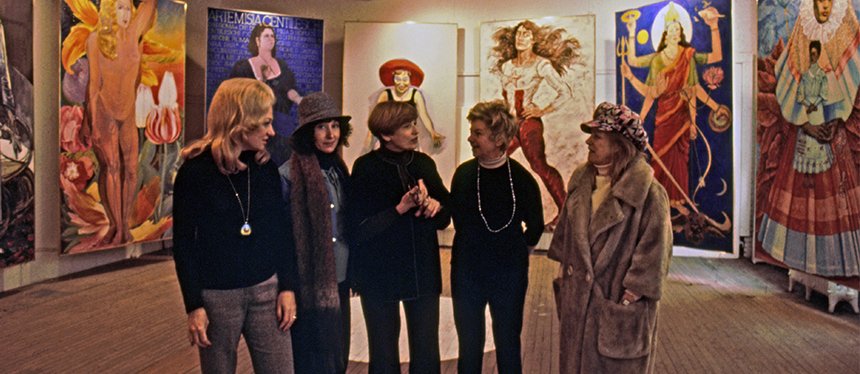The Sister Chapel
The Sister Chapel
THE SISTER CHAPEL
The Sister Chapel historic collaborative installation was unveiled to the public on January 15, 1978, at P.S.1 (now MoMA PS1) in New York. Although it subsequently traveled to three other exhibition venues, The Sister Chapel was absent from view between 1980 and 2016. Since its permanent installation at the Center for Art and Social Engagement in 2019, The Sister Chapel has been experienced by countless visitors who stand beneath the towering circle of inspirational female "role models" and see themselves reflected in the mirrored portion of the monumental ceiling. As characterized by Ilise Greenstein, The Sister Chapel was "a major statement on women" and "a portrayal of how women artists see other women." The highly individual nature of each artist's subject matter and style produced a visually complex and symbolically varied group of works, yet the paintings are simultaneously united by their dimensions and scale. While The Sister Chapel is now recognized as a historically significant art installation, it was always intended to transcend that moment in 1978 when viewers first entered the circular arrangement of canvases. As Ilise Greenstein wrote to her collaborators in 1980, "It is not in the past, but always in the present: she provides a continuous dialogue with women everywhere."
The Sister Chapel was conceived in 1974 by Ilise Greenstein, who envisioned a monumental “hall of fame” in which women’s achievements would be presented from a female perspective. Greenstein’s participation in several feminist consciousness-raising groups and all-women activist organizations prompted her to question the enduring androcentric view of history. Using a nominal pun on the Sistine Chapel, she proposed a secular, nonhierarchical alternative to the patriarchal system embodied in Michelangelo’s renowned ceiling fresco.
In the spirit of feminist solidarity, Greenstein collaborated with twelve other women, whose individual contributions shaped the character and appearance of The Sister Chapel. The artists collectively established uniform dimensions for the figure paintings and agreed that each canvas would depict a standing female “role model.” The particular subject and manner of execution were left entirely to the creator of each painting. As a result, the canvases form a visually cohesive group without diminishing the individuality of any artist. Diverse contemporary and historical women, deities, and conceptual figures populate the all-female pantheon of The Sister Chapel. Above them, Greenstein’s enormous abstract ceiling features a mirrored center to remind visitors that there is no limit to women’s potential.
The Sister Chapel premiered in January 1978 at P.S.1, an experimental exhibition space in Long Island City, New York. The installation traveled to three other venues between 1978 and 1980, but its presentation was hindered by architectural and spatial limitations. Displayed near the circle of monumental paintings was the model for an unrealized fabric structure, which was designed by Maureen Connor to house the abstract ceiling and figural canvases. The fabric pavilion was finally constructed when The Sister Chapel returned to public view at Rowan University in 2016. Three years later, the installation was made permanent by a generous gift from the Shirley Gorelick Foundation. Special thanks to Steven Earl Weber for the reengineered chapel, fabrication, and installation of this permanent work.
June Blum / Maureen Connor / Martha Edelheit / Elsa M. Goldsmith / Shirley Gorelick / Ilise Greenstein / Betty Holliday / Diana Kurz / Cynthia Mailman / Alice Neel / Sylvia Sleigh / May Stevens / Sharon Wybrants
Hear more: The Sister Chapel, episode 11/19/22, Rowan Radio 89.7 WGLS-FM
Read more: ‘The Sister Chapel’ presents women’s achievements from a female perspective, NJ Indy; Gallery Shows: The Sister Chapel at Rowan, The Philadelphia Inquirer; After 35 Years, Lost Feminist Art Back on Display, The Philadelphia Inquirer; God Is A Woman in Previously Forgotten Feminist Exhibit The Sister Chapel, Huffington Post; Major Feminish Art Installation The Sister Chapel Resurrected After 37 Years, Artnet News; Exhibit Honors 12 Female Artist Creators & Pioneers of The Sister Chapel, The Examiner
Enjoy this video produced by State of the Arts
Enjoy this walk through talk with Professor Andrew Hottle
VISITOR INFORMATION
The Center for Art and Social Engagement Gallery
Westby Hall, First Floor, Room 110
237 Mullica Hill Road, Glassboro, NJ 08028
The CASE Gallery has open hours during the academic year. Please note that the CASE Gallery closes during summer months, spring break, and winter break. View our visitor information page for additional information about planning your visit.

The Sister Chapel Catalog: View and Download Full PDF Catalog
The Sister Chapel: An Essential Feminist Collaboration
Exhibition Catalog
Essay by Andrew D. Hottle



